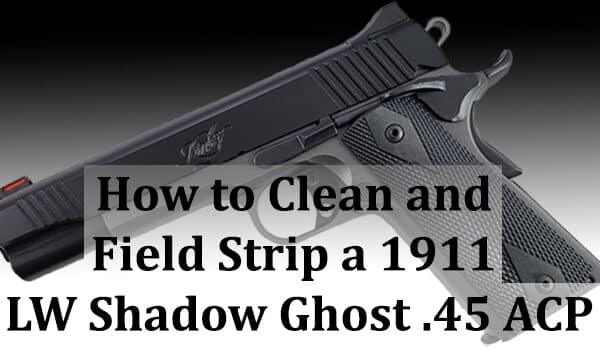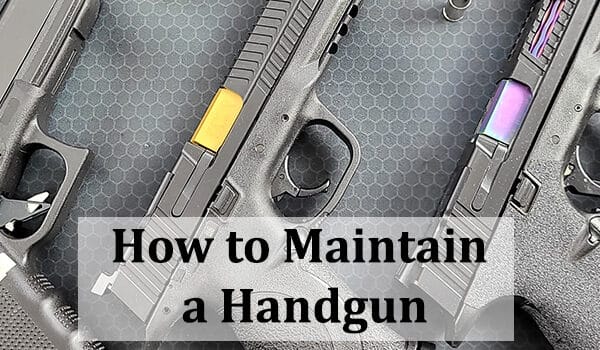An Overview of How, Why, and When to Clean Firearms
Hey there, fellow firearm enthusiasts! As a firearms professional with years of experience, I understand the importance of keeping our guns in top-notch condition. Regular cleaning ensures the reliability and longevity of our firearms and promotes safe and accurate shooting. In this blog post, I’ll guide you through cleaning a gun, step by step, with practical tips and expert advice. Let’s dive in!
Table of contents
Why Clean Your Firearms
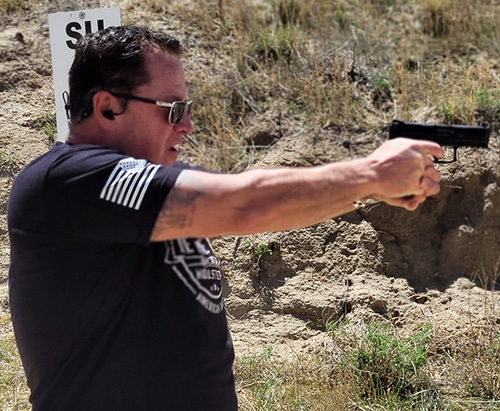
Cleaning your firearms is crucial for several reasons. Firstly, regular cleaning ensures the proper functioning and reliability of your firearm. Over time, residue, dirt, and debris can accumulate in the barrel, chamber, and other critical parts, leading to malfunctions or complete failures. By cleaning your firearms, you remove these contaminants, maintaining the smooth operation of the firearm and reducing the risk of jams or misfires.
Secondly, cleaning your firearms helps to preserve their longevity. Firearms are often made of metal, which can be susceptible to corrosion and rust if not properly maintained. Cleaning and lubricating the various components of your firearm create a protective barrier against moisture and other corrosive elements. By preventing rust and corrosion, you extend the lifespan of your firearm and maintain its value.
Furthermore, cleaning your firearms is essential for safety. When firing a gun, residue, and fouling accumulate in the barrel, creating a material layer that can affect the accuracy and increase the pressure inside the firearm. Regular cleaning ensures the barrel is clear and free from obstructions, allowing the bullet to travel smoothly and accurately. Additionally, inspecting and cleaning your firearm can identify potential issues or defects that may compromise its safety, such as damaged parts or worn-out springs.
When to Clean Your Firearms
The frequency of cleaning largely depends on several factors, such as the type of firearm, the number of rounds fired, and the conditions in which it was used. As a general guideline, cleaning your firearms after each shooting session is recommended. This ensures that any residue, fouling, or debris accumulated during use is promptly removed. Additionally, suppose your firearm has been exposed to harsh environmental conditions, such as rain, mud, or dust. In that case, cleaning it as soon as possible is essential to prevent corrosion and damage. Regular cleaning includes periodic deep cleaning, where you disassemble the firearm to clean hard-to-reach areas, inspect for wear and tear, and apply lubrication to ensure smooth operation. A proactive approach to cleaning your firearms will help maintain their reliability, longevity, and safety.
Gather Your Cleaning Supplies
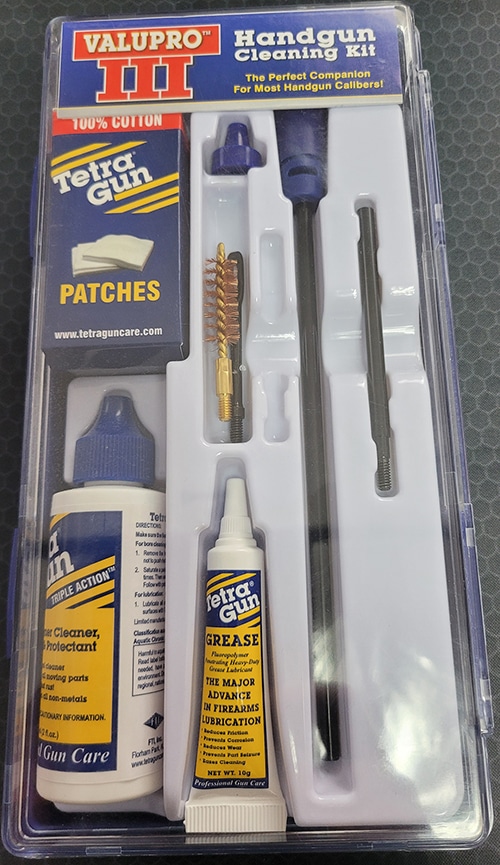
If you are reading this, there is a good chance you are new to cleaning firearms. If so, buying a kit with the tools listed below is a great way to start. There are many on the market, and they can be fairly inexpensive. Some even include lubricant, bore cleaner and gun oil; if not, those products can also be purchased fairly inexpensively, and once purchased, they will last for many cleanings.
I recommend starting with an inexpensive kit, learning what you like and don’t like about it, and then upgrading to other products as you get more experience cleaning your firearms. If you have been cleaning for a while, know the products you want to upgrade, and are looking for recommendations, please try our “All About Cleaning Your Handgun” post.
Before we start, it’s crucial to have the right tools at hand. Here’s a list of essential cleaning supplies you’ll need:
- Cleaning Kit:
- Cleaning rod with attachments (jag, slotted tip, bore brush)
- Bore snake or cleaning patches
- Cleaning solvent
- Lubricant
- A toothbrush or small nylon brush
- Cotton swabs
- Microfiber cloth
- Gun oil or preservative
- Safety Equipment:
- Safety glasses
- Disposable gloves (optional)
- Workspace Preparation:
- Cleaning mat or old towel
- Well-ventilated area
- Adequate lighting
Unloading and Safety First
Safety should always be the top priority when handling firearms. Before cleaning, follow these steps:
- Unload the firearm:
- Remove the magazine (if applicable).
- Check and clear the chamber to ensure it’s empty.
- Double-check for any remaining ammunition.
- Choose a suitable workspace:
- Select a well-ventilated area away from distractions.
- Ensure the firearm is pointed in a safe direction at all times.
- Lay down a cleaning mat or an old towel to protect surfaces.
Disassembly and Cleaning Process
Now that we have our supplies ready and safety precautions in place let’s dive into the step-by-step process of cleaning a gun:

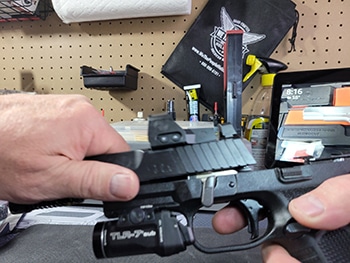
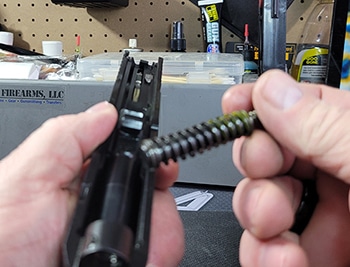
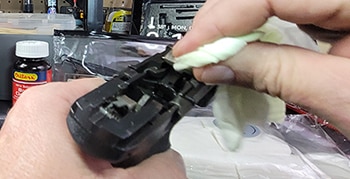


- Disassembly:
- Consult the firearm’s manual for specific disassembly instructions. We also have several videos and blog posts on various firearms in the Gun Cleaning category on our blog.
- Remove the slide, barrel, and recoil spring assembly (for semi-automatic pistols).
- For revolvers, remove the cylinder and extractor.
- Cleaning the Barrel:
- Attach a bore brush to the cleaning rod.
- Apply a suitable cleaning solvent to the brush.
- Insert the brush into the chamber and push it through the barrel in a back-and-forth motion.
- Remove the brush, attach a patch, or use a bore snake to remove residue and excess solvent.
- Repeat the process until the patches come out clean.
- Run a dry patch through the barrel to ensure it’s dry.
- Cleaning the Action:
- Use a toothbrush or nylon brush to remove dirt, residue, and carbon buildup from the slide, frame, and other components.
- Dip a cotton swab into the cleaning solvent and clean hard-to-reach areas.
- Wipe all surfaces with a microfiber cloth.
- Lubrication:
- Apply a small amount of lubricant to the slide, frame rails, barrel hood, and other moving parts.
- Use a clean cloth to spread the lubricant evenly.
- Avoid over-lubrication, as excess oil can attract dirt and debris.
- Reassembly:
- Follow the firearm’s manual to reassemble all components correctly.
- Ensure everything fits snugly and operates smoothly.
- Perform a function check to verify proper functioning.
Proper Storage and Maintenance
After cleaning, storing your firearms properly and performing regular maintenance is crucial. Here are a few important tips:
- Storage:
- Store firearms unloaded and in a locked container or safe.
- Use gun socks or silicone-treated gun cases to protect against moisture and rust.
- Keep ammunition separate from firearms in a secure location.
- Regular Maintenance:
- Inspect your firearm regularly for any wear, rust, or damage.
- Wipe down the exterior with a microfiber cloth to remove fingerprints and dirt.
- Apply a light gun oil or preservative coat to prevent rust and corrosion.
- Function Check:
- Before each use, perform a function check to ensure the firearm operates smoothly and reliably.
- Test the trigger pull, magazine release, slide operation, and safety mechanisms.
- Follow the Manufacturer’s Guidelines:
- Refer to the firearm manufacturer’s manual for specific cleaning and maintenance instructions.
- Different firearms may have unique requirements, so following their recommendations is essential.
How to Clean a Gun Conclusion
Congratulations! You have now learned what steps are taken to clean your firearm. Following the step-by-step process outlined in this guide, you can maintain your firearms in top condition, ensuring their reliability, accuracy, and longevity.
Remember, safety should always be your foremost concern when handling firearms. Before cleaning, ensure your gun is unloaded, choose a suitable workspace, and wear appropriate safety gear such as safety glasses and gloves.
Gathering the necessary cleaning supplies, including a cleaning kit, will make the process smoother and more efficient. Preparing a dedicated workspace with proper lighting and ventilation will also provide a more pleasant cleaning experience.
The cleaning process involves disassembly, thorough cleaning of the barrel and action, proper lubrication, and reassembly following the manufacturer’s instructions. Take your time, pay attention to detail, and don’t hesitate to consult your firearm’s manual for specific guidance.
Once your gun is clean, remember proper storage and regular maintenance. Storing your firearm in a secure, locked container or safe, and performing routine inspections, wiping, and lubrication will help protect it from damage and ensure its optimal performance.
Stay responsible, stay safe, and enjoy owning a well-maintained firearm. Happy shooting!
How to Clean a Gun FAQ
The frequency of cleaning depends on how often you use your firearm. As a general rule of thumb, it’s recommended to clean your gun after every shooting session or at least once every few months if it remains unused. Regular cleaning and maintenance will help keep your firearm in optimal condition.
It’s important to use cleaning solvents and lubricants specifically designed for firearms. These products are formulated to remove carbon buildup and protect against corrosion effectively. Avoid using household cleaners or excessive amounts of lubricants, as they may damage the firearm’s components.
The level of disassembly required for cleaning depends on the firearm type and the manufacturer’s recommendations. While a field strip or partial disassembly is often sufficient for routine cleaning, a complete disassembly may be necessary for deep cleaning or addressing specific issues. Consult your firearm’s manual or seek professional guidance if you’re unsure about the disassembly process.
While it’s important to maintain a clean firearm, excessive cleaning can be counterproductive. Over-cleaning can cause unnecessary wear to the gun’s components and potentially strip away essential lubrication. Stick to a regular cleaning schedule and avoid excessive cleaning unless there is a specific need.


